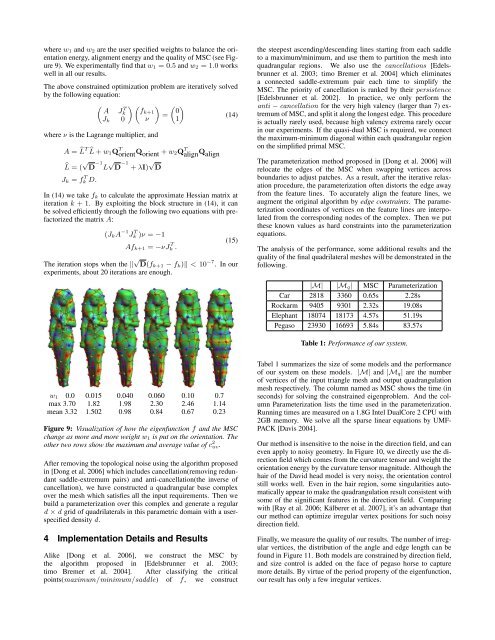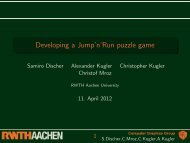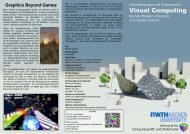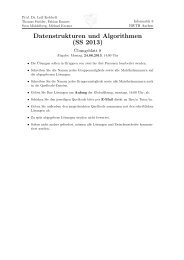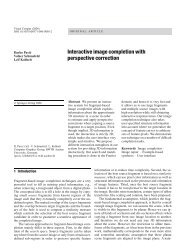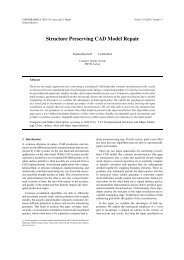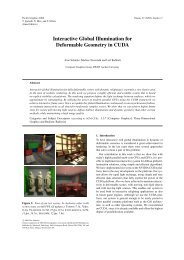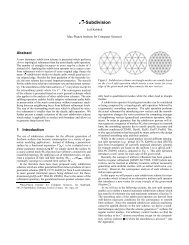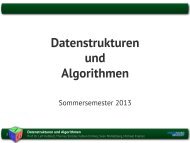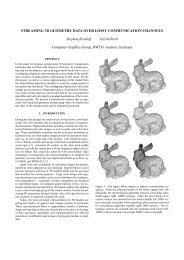Paper - Computer Graphics and Multimedia - RWTH Aachen ...
Paper - Computer Graphics and Multimedia - RWTH Aachen ...
Paper - Computer Graphics and Multimedia - RWTH Aachen ...
You also want an ePaper? Increase the reach of your titles
YUMPU automatically turns print PDFs into web optimized ePapers that Google loves.
where w 1 <strong>and</strong> w 2 are the user specified weights to balance the orientation<br />
energy, alignment energy <strong>and</strong> the quality of MSC (see Figure<br />
9). We experimentally find that w 1 = 0.5 <strong>and</strong> w 2 = 1.0 works<br />
well in all our results.<br />
The above constrained optimization problem are iteratively solved<br />
by the following equation:<br />
( ) ( ) (<br />
A J<br />
T<br />
k fk+1 0<br />
=<br />
(14)<br />
J k 0 ν 1)<br />
where ν is the Lagrange multiplier, <strong>and</strong><br />
A = ̂L T ̂L + w1Q T orient Q orient + w2QT align Q align<br />
̂L = ( √ D −1 L √ D −1 + λI) √ D<br />
J k = f T k D.<br />
In (14) we take f k to calculate the approximate Hessian matrix at<br />
iteration k + 1. By exploiting the block structure in (14), it can<br />
be solved efficiently through the following two equations with prefactorized<br />
the matrix A:<br />
(J k A −1 J T k )ν = −1<br />
Af k+1 = −νJ T k .<br />
(15)<br />
The iteration stops when the ‖ √ D(f k+1 − f k )‖ < 10 −7 . In our<br />
experiments, about 20 iterations are enough.<br />
the steepest ascending/descending lines starting from each saddle<br />
to a maximum/minimum, <strong>and</strong> use them to partition the mesh into<br />
quadrangular regions. We also use the cancellations [Edelsbrunner<br />
et al. 2003; timo Bremer et al. 2004] which eliminates<br />
a connected saddle-extremum pair each time to simplify the<br />
MSC. The priority of cancellation is ranked by their persistence<br />
[Edelsbrunner et al. 2002]. In practice, we only perform the<br />
anti − cancellation for the very high valency (larger than 7) extremum<br />
of MSC, <strong>and</strong> split it along the longest edge. This procedure<br />
is actually rarely used, because high valency extrema rarely occur<br />
in our experiments. If the quasi-dual MSC is required, we connect<br />
the maximum-minimum diagonal within each quadrangular region<br />
on the simplified primal MSC.<br />
The parameterization method proposed in [Dong et al. 2006] will<br />
relocate the edges of the MSC when swapping vertices across<br />
boundaries to adjust patches. As a result, after the iterative relaxation<br />
procedure, the parameterization often distorts the edge away<br />
from the feature lines. To accurately align the feature lines, we<br />
augment the original algorithm by edge constraints. The parameterization<br />
coordinates of vertices on the feature lines are interpolated<br />
from the corresponding nodes of the complex. Then we put<br />
these known values as hard constraints into the parameterization<br />
equations.<br />
The analysis of the performance, some additional results <strong>and</strong> the<br />
quality of the final quadrilateral meshes will be demonstrated in the<br />
following.<br />
|M| |M q| MSC Parameterization<br />
Car 2818 3360 0.65s 2.28s<br />
Rockarm 9405 9301 2.32s 19.08s<br />
Elephant 18074 18173 4.57s 51.19s<br />
Pegaso 23930 16693 5.84s 83.57s<br />
Table 1: Performance of our system.<br />
w 1 0.0 0.015 0.040 0.060 0.10 0.7<br />
max 3.70 1.82 1.98 2.30 2.46 1.14<br />
mean 3.32 1.502 0.98 0.84 0.67 0.23<br />
Figure 9: Visualization of how the eigenfunction f <strong>and</strong> the MSC<br />
change as more <strong>and</strong> more weight w 1 is put on the orientation. The<br />
other two rows show the maximum <strong>and</strong> average value of c 2 uv.<br />
After removing the topological noise using the algorithm proposed<br />
in [Dong et al. 2006] which includes cancellation(removing redundant<br />
saddle-extremum pairs) <strong>and</strong> anti-cancellation(the inverse of<br />
cancellation), we have constructed a quadrangular base complex<br />
over the mesh which satisfies all the input requirements. Then we<br />
build a parameterization over this complex <strong>and</strong> generate a regular<br />
d × d grid of quadrilaterals in this parametric domain with a userspecified<br />
density d.<br />
4 Implementation Details <strong>and</strong> Results<br />
Alike [Dong et al. 2006], we construct the MSC by<br />
the algorithm proposed in [Edelsbrunner et al. 2003;<br />
timo Bremer et al. 2004]. After classifying the critical<br />
points(maximum/minimum/saddle) of f, we construct<br />
Tabel 1 summarizes the size of some models <strong>and</strong> the performance<br />
of our system on these models. |M| <strong>and</strong> |M q| are the number<br />
of vertices of the input triangle mesh <strong>and</strong> output quadrangulation<br />
mesh respectively. The column named as MSC shows the time (in<br />
seconds) for solving the constrained eigenproblem. And the column<br />
Parameterization lists the time used in the parameterization.<br />
Running times are measured on a 1.8G Intel DualCore 2 CPU with<br />
2GB memory. We solve all the sparse linear equations by UMF-<br />
PACK [Davis 2004].<br />
Our method is insensitive to the noise in the direction field, <strong>and</strong> can<br />
even apply to noisy geometry. In Figure 10, we directly use the direction<br />
field which comes from the curvature tensor <strong>and</strong> weight the<br />
orientation energy by the curvature tensor magnitude. Although the<br />
hair of the David head model is very noisy, the orientation control<br />
still works well. Even in the hair region, some singularities automatically<br />
appear to make the quadrangulation result consistent with<br />
some of the significant features in the direction field. Comparing<br />
with [Ray et al. 2006; Kälberer et al. 2007], it’s an advantage that<br />
our method can optimize irregular vertex positions for such noisy<br />
direction field.<br />
Finally, we measure the quality of our results. The number of irregular<br />
vertices, the distribution of the angle <strong>and</strong> edge length can be<br />
found in Figure 11. Both models are constrained by direction field,<br />
<strong>and</strong> size control is added on the face of pegaso horse to capture<br />
more details. By virtue of the period property of the eigenfunction,<br />
our result has only a few irregular vertices.


